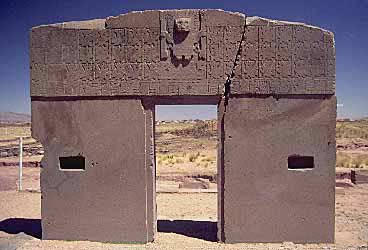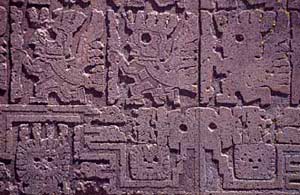In the Northwest corner of the Carachacha Square in the city of Tiahuanaco lies a massive and famous stone sculpture known as the Sun Gate – one of the most remarkable achievements of the ancient civilization renowned across South America.
 |
|
Sun Gate (Photo: dudeman) |
The Sun Gate is formed from a gigantic block of volcanic rock, measuring 3.1 meters high, 3.96 meters wide, and weighing over 10 tons. It is called the Sun Gate because on September 21, during the Autumn Equinox, the first rays of sunlight shine down onto the ground at the center of this stone gateway.
Those who have seen the Sun Gate cannot help but be awed by its majestic beauty. Intricate carvings adorn the Sun Gate, with the most prominent being the Sun Calendar depicted horizontally across the top of the archway. In the center of the Sun Gate is the figure of the flying god (the god of flight). According to legend, he is the saint who introduced various forms of art and governance to South America. The statue wears a regal crown and holds a staff adorned with a condor, displaying a serious demeanor, with two small tears streaming from the corners of his eyes. Flanking the flying god are rows of fierce warriors. Below the Sun Calendar is a type of geometric pattern arranged continuously in the form of a pyramid. Additionally, countless other designs and inscriptions are depicted, the meanings of which remain unexplained to this day.
Standing before the Sun Gate, one often wonders: “Why did the inhabitants of ancient Tiahuanaco construct such a grand stone gateway?”
Considering the rays of sunlight passing through the Sun Gate during the Autumn Equinox, it is clear that this structure is related to the calendar. Many scholars believe that most of the figures and symbols carved on the Sun Gate are associated with calendrical calculations.
But how do these symbols express calendrical concepts? How did the Tiahuanaco people accurately calculate the relationship between the rays of sunlight during the Autumn Equinox and the position of the Sun Gate?
In the book “The Random Phenomenon of Tiahuanaco”, scientists Bellermi and Aluan meticulously studied the designs and symbols of the Sun Gate. They believe that the upper part of the Sun Gate records a significant amount of astronomical knowledge, dating back at least 2,700 years, based on the understanding that the Earth is round. This raises yet another question: “Did prehistoric Tiahuanaco truly exist within a civilization that achieved such a high level of development?”
While examining the Sun Gate, British scholar Hanke discovered that there are also carvings of bizarre prehistoric animals on the arch. These creatures appear stout, with four somewhat coarse legs, resembling a hybrid between a hippopotamus and a buffalo.
In today’s animal kingdom, no such creature seems to exist. However, paleontologists have quickly identified the sluggish animal depicted in the carvings as the “toothless mammal” – a prehistoric species that has since gone extinct.
Research findings indicate that the toothless mammal lived between 1.6 million and 12,000 years ago and likely had amphibious traits akin to modern hippos. It was the most common hoofed animal on the American continent at that time. This creature measured approximately 2.8 meters in length, stood 1.4 meters tall, had three toes similar to a buffalo but was shorter and hornless, with a significant gap between its incisors, hence the name “toothless mammal.” However, it became extinct around 12,000 years ago. Today, our understanding of this animal comes from fossils that have been discovered.
So, why are extinct prehistoric animals depicted on the Sun Gate? There are over 47 instances on the arch of the Sun Gate featuring the likeness of the toothless mammal. This unattractive creature is not only seen on the Sun Gate but is also depicted on various broken pottery from the same era, with several sculptures still showing its complete form.
In fact, the ancient animal depictions on the Sun Gate and Feijin primarily represent the toothless mammal. Additionally, the carvings on the Sun Gate also feature a long-nosed animal resembling an elephant. Today, the large elephant species in South America has gone extinct. However, research documents indicate that in prehistoric times, South America was home to a species similar to the elephant, scientifically named Juxiak.
 |
|
Carvings surrounding the flying god |
These long-nosed animals were most populous in the Tiahuanaco region, particularly in the southern part of the Altiplano mountain range. However, this species also went extinct around 10,000 years ago.
The frequent depictions of extinct animals from over 10,000 years ago at the ancient site of Tiahuanaco signify what? They can only prove that the first builders of Tiahuanaco frequently encountered these animals, real elephants, and did not merely rely on imagination to depict the toothless mammals on the Sun Gate. Thus, we can infer that the construction of Tiahuanaco and the Sun Gate cannot be later than the Late Prehistoric period, around 10,000 years ago.
However, the Egyptian Pyramids were constructed around 2,600 BC, while the earliest recognized civilization, Sumer, only began around 3,300 BC. The migration of humans to the Americas is estimated to have occurred around 10,000 years ago, with the arrival in America likely being even later. So who built the magnificent Tiahuanaco and the incredibly wondrous Sun Gate 12,000 years ago, when the contemporary world was still shrouded in darkness?
What adds to the mystery is that the Sun Gate – a masterpiece unmatched today – is not entirely completed. The arch clearly shows unfinished carvings. Could it be that one day, the sculpting work suddenly stopped? What event could have occurred here, or was there an unforeseen disaster?
The Sun Gate (Thái Dương môn) – A mystical gateway – The Door of Wisdom.


















































